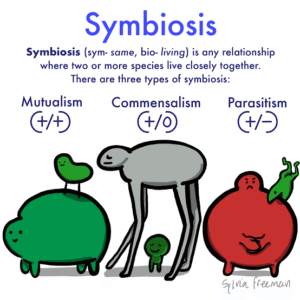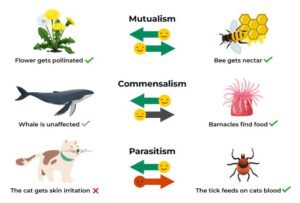Back to: MICROBIOLOGY 100 LEVEL
Welcome to class!
Hello, champion learner! It’s always a joy having you here. You’re doing so well, and today’s topic will open your eyes to some of the most fascinating relationships in the microbial world—Symbiosis, Parasitism, and Commensalism. Just like people have different kinds of friendships, microbes also form special relationships with plants, animals, and even humans. Some help, some harm, and some just tag along!
Symbiosis, Parasitism, Commensalism
Symbiosis
Let’s start with symbiosis, a general term that means “living together”. It describes a close and long-term relationship between two different organisms. The organisms involved are called symbionts. There are three main types: mutualism, parasitism, and commensalism.
Mutualism (Both Benefit)
In mutualism, both organisms benefit from the relationship. It’s like a perfect partnership.

Example:
Rhizobium bacteria live in the root nodules of legumes like beans and groundnuts. The plant provides shelter and nutrients, while the bacteria fix nitrogen for the plant to grow better. It’s a win-win!
Another Example:
Inside your intestines, there are friendly bacteria like Lactobacillus that help you digest food and produce vitamins. In return, they get food and a warm place to live.
Parasitism (One Benefits, One is Harmed)
In parasitism, one organism (the parasite) benefits, while the other (the host) is harmed. Parasites often depend on the host for food, energy, or shelter, but they usually don’t kill the host quickly because they still need it to survive.
Example:
The malaria parasite Plasmodium lives in human red blood cells. It multiplies there, causing illness, fever, and sometimes death. The parasite gains, but the human host suffers.
Another Example:
Tapeworms live in the intestines of humans and animals, feeding on digested food and causing weight loss or weakness.
Commensalism (One Benefits, the Other is Unaffected)
In commensalism, one organism benefits, and the other is neither helped nor harmed. It’s a peaceful “just passing by” relationship.
Example:
Some bacteria live on your skin, feeding on dead skin cells without harming you. You may not even notice they’re there!
Another Example:
Birds that ride on the backs of cattle eat insects stirred up by their movement. The bird gets food, and the cattle are not affected.
Relatable Example:
Think of these relationships like everyday friendships:
Mutualism is like two classmates helping each other study.

Parasitism is like someone copying your homework and giving you stress.
Commensalism is like someone sitting next to you on the bus—just sharing space, no harm, no help.
Summary
- Symbiosis means living closely together, and it includes mutualism, parasitism, and commensalism.
- Mutualism benefits both partners.
- Parasitism benefits one while harming the other.
- Commensalism benefits one without affecting the other.
Evaluation
- What is symbiosis?
- Give one example of mutualism involving microbes.
- Name one parasite and explain how it affects its host.
- What is commensalism?
- Can a relationship move from mutualism to parasitism? Think and explain.
You’re learning the secrets of how life works, and that’s powerful knowledge. Keep going strong with Afrilearn—we’re proud of you, and the world is waiting for your brilliance!
